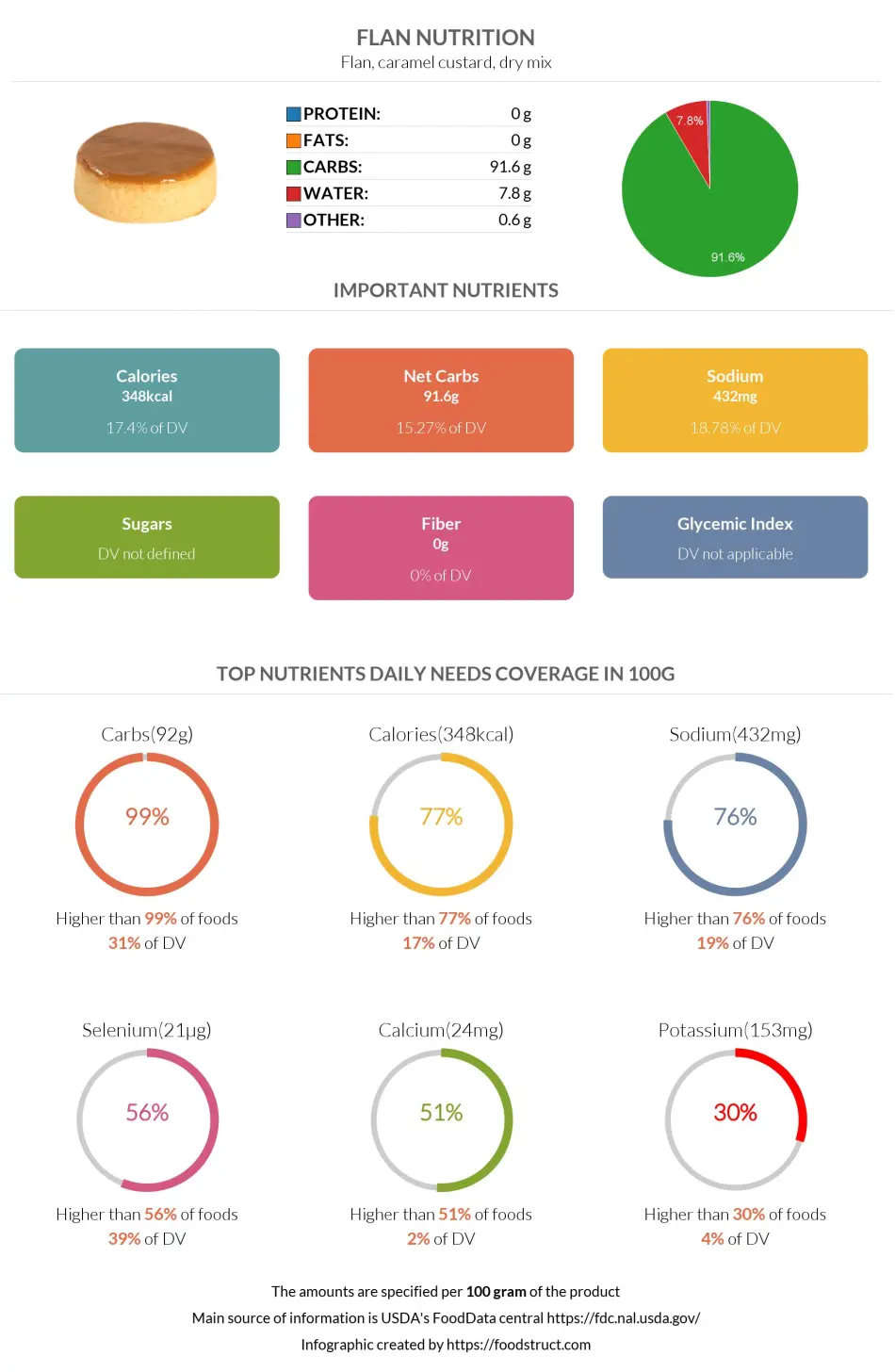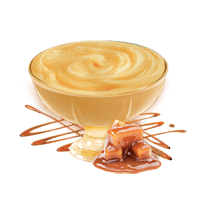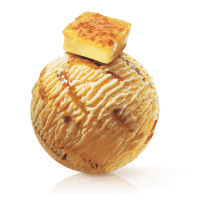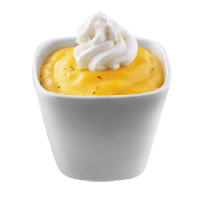Flan nutrition: calories, carbs, GI, protein, fiber, fats
Flan, caramel custard, dry mix
*all the values are displayed for the amount of 100 grams
Top nutrition facts for Flan

| Calories ⓘ Calories for selected serving | 348 kcal |
|
Glycemic index ⓘ
Source:
Check out our Glycemic index chart page for the full list.
|
66 (medium) |
| Glycemic load | 13 (medium) |
| Net Carbs ⓘ Net Carbs = Total Carbohydrates – Fiber – Sugar Alcohols | 92 grams |
| Default serving size ⓘ Serving sizes are mostly taken from FDA's Reference Amounts Customarily Consumed (RACCs) | 1 portion, amount to make 1/2 cup (21 grams) |
| Acidity (Based on PRAL) ⓘ PRAL (Potential renal acid load) is calculated using a formula. On the PRAL scale the higher the positive value, the more is the acidifying effect on the body. The lower the negative value, the higher the alkalinity of the food. 0 is neutral. | -3.5 (alkaline) |
Flan calories (kcal)
| Calories for different serving sizes of flan | Calories | Weight |
|---|---|---|
| Calories in 100 grams | 348 | |
| Calories in 1 portion, amount to make 1/2 cup | 73 | 21 g |
| Calories for different varieties of flan | Calories | Weight |
|---|---|---|
| Flan, caramel custard, dry mix (this food) | 348 | 100 g |
| Flan, caramel custard, dry mix, prepared with 2% milk | 103 | 100 g |
| Flan, caramel custard, dry mix, prepared with whole milk | 113 | 100 g |
Flan Glycemic index (GI)
Source:
Check out our Glycemic index chart page for the full list.
Flan Glycemic load (GL)
Mineral coverage chart
Mineral chart - relative view
Macronutrients chart
Protein:
Daily Value: 0%
0 g of 50 g
0 g (0% of DV )
Fats:
Daily Value: 0%
0 g of 65 g
0 g (0% of DV )
Carbs:
Daily Value: 31%
91.6 g of 300 g
91.6 g (31% of DV )
Water:
Daily Value: 0%
7.8 g of 2,000 g
7.8 g (0% of DV )
Other:
0.6 g
0.6 g
All nutrients for Flan per 100g
| Nutrient | Value | DV% | In TOP % of foods | Comparison |
| Vitamin A | 0µg | 0% | 100% | |
| Calories | 348kcal | 17% | 23% |
7.4 times more than Orange
|
| Protein | 0g | 0% | 100% |
N/A
|
| Fats | 0g | 0% | 100% |
N/A
|
| Vitamin C | 0mg | 0% | 100% |
N/A
|
| Net carbs | 92g | N/A | 0% |
1.7 times more than Chocolate
|
| Carbs | 92g | 31% | 1% |
3.3 times more than Rice
|
| Cholesterol | 0mg | 0% | 100% |
N/A
|
| Magnesium | 0mg | 0% | 100% |
N/A
|
| Calcium | 24mg | 2% | 49% |
5.2 times less than Milk
|
| Potassium | 153mg | 5% | 70% |
Equal to Cucumber
|
| Iron | 0.08mg | 1% | 94% |
32.5 times less than Beef broiled
|
| Fiber | 0g | 0% | 100% |
N/A
|
| Copper | 0.02mg | 2% | 94% |
9.5 times less than Shiitake
|
| Zinc | 0.04mg | 0% | 95% |
157.8 times less than Beef broiled
|
| Phosphorus | 1mg | 0% | 97% |
182 times less than Chicken meat
|
| Sodium | 432mg | 19% | 24% |
1.1 times less than White bread
|
| Manganese | 0.01mg | 0% | 94% | |
| Selenium | 21µg | 39% | 44% | |
| Vitamin B1 | 0mg | 0% | 100% |
N/A
|
| Vitamin B2 | 0mg | 0% | 100% |
N/A
|
| Vitamin B3 | 0mg | 0% | 100% |
N/A
|
| Vitamin B5 | 0mg | 0% | 100% |
N/A
|
| Vitamin B6 | 0mg | 0% | 100% |
N/A
|
| Vitamin B12 | 0µg | 0% | 100% |
N/A
|
| Folate | 0µg | 0% | 100% |
N/A
|
| Caffeine | 0mg | 0% | 100% |
Check out similar food or compare with current
NUTRITION FACTS LABEL
Nutrition Facts
___servings per container
Serving Size ______________
Serving Size ______________
Amount Per 100g
Calories 348
% Daily Value*
0
Total Fat
0g
0
Saturated Fat 0g
0
Trans Fat
0g
0
Cholesterol 0mg
19%
Sodium 432mg
31%
Total Carbohydrate
92g
0
Dietary Fiber
0g
Total Sugars 0g
Includes ? g Added Sugars
Protein
0g
Vitamin D
0mcg
0
Calcium
24mg
2.4%
Iron
0.08mg
1%
Potassium
153mg
4.5%
*
The % Daily Value (DV) tells you how much a nutrient in a serving of food contributes to a daily diet. 2,000 calories a day is used for general nutrition advice.
Health checks
ⓘ
Dietary cholesterol is not associated with an increased risk of coronary heart disease in healthy individuals. However, dietary cholesterol is common in foods that are high in harmful saturated fats.
Source
Low in Cholesterol
ⓘ
Trans fat consumption increases the risk of cardiovascular disease and mortality by negatively affecting blood lipid levels.
Source
No Trans Fats
ⓘ
Saturated fat intake can raise total cholesterol and LDL (low-density lipoprotein) levels, leading to an increased risk of atherosclerosis. Dietary guidelines recommend limiting saturated fats to under 10% of calories a day.
Source
Low in Saturated Fats
ⓘ
While the consumption of moderate amounts of added sugars is not detrimental to health, an excessive intake can increase the risk of obesity, and therefore, diabetes.
Source
Low in Sugars
Flan nutrition infographic

Infographic link
References
All the values for which the sources are not specified explicitly are taken from FDA’s Food Central. The exact link to the food presented on this page can be found below.


